Kyoung Mu Lee
Meta-Learning with Adaptive Hyperparameters
Oct 31, 2020
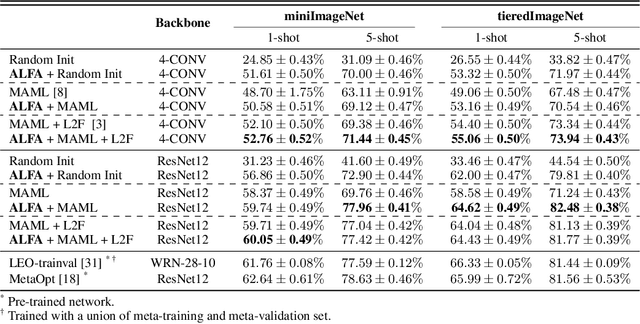

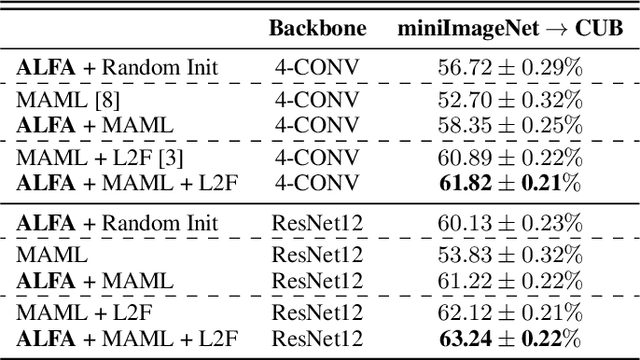
Abstract:Despite its popularity, several recent works question the effectiveness of MAML when test tasks are different from training tasks, thus suggesting various task-conditioned methodology to improve the initialization. Instead of searching for better task-aware initialization, we focus on a complementary factor in MAML framework, inner-loop optimization (or fast adaptation). Consequently, we propose a new weight update rule that greatly enhances the fast adaptation process. Specifically, we introduce a small meta-network that can adaptively generate per-step hyperparameters: learning rate and weight decay coefficients. The experimental results validate that the Adaptive Learning of hyperparameters for Fast Adaptation (ALFA) is the equally important ingredient that was often neglected in the recent few-shot learning approaches. Surprisingly, fast adaptation from random initialization with ALFA can already outperform MAML.
AIM 2020 Challenge on Video Temporal Super-Resolution
Sep 28, 2020
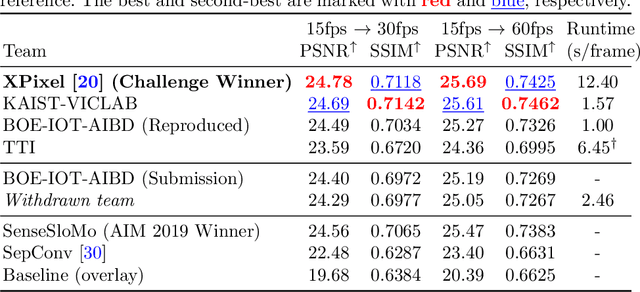

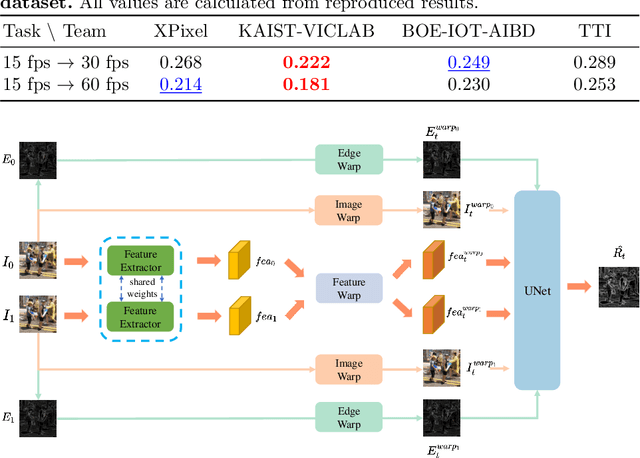
Abstract:Videos in the real-world contain various dynamics and motions that may look unnaturally discontinuous in time when the recordedframe rate is low. This paper reports the second AIM challenge on Video Temporal Super-Resolution (VTSR), a.k.a. frame interpolation, with a focus on the proposed solutions, results, and analysis. From low-frame-rate (15 fps) videos, the challenge participants are required to submit higher-frame-rate (30 and 60 fps) sequences by estimating temporally intermediate frames. To simulate realistic and challenging dynamics in the real-world, we employ the REDS_VTSR dataset derived from diverse videos captured in a hand-held camera for training and evaluation purposes. There have been 68 registered participants in the competition, and 5 teams (one withdrawn) have competed in the final testing phase. The winning team proposes the enhanced quadratic video interpolation method and achieves state-of-the-art on the VTSR task.
Domain Adaptation of Learned Features for Visual Localization
Aug 21, 2020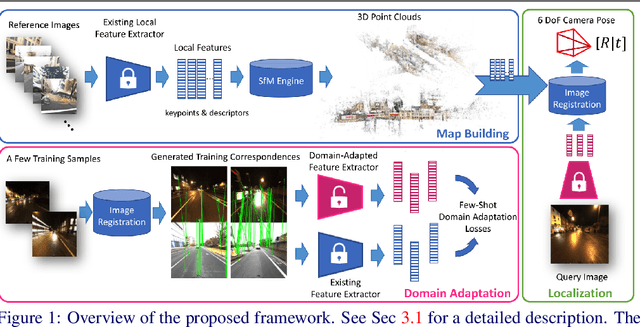

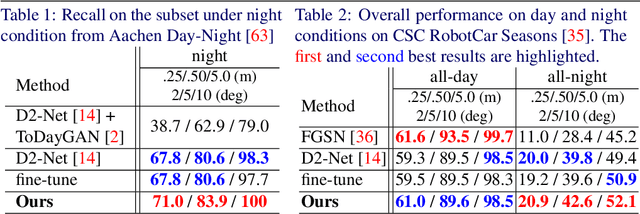
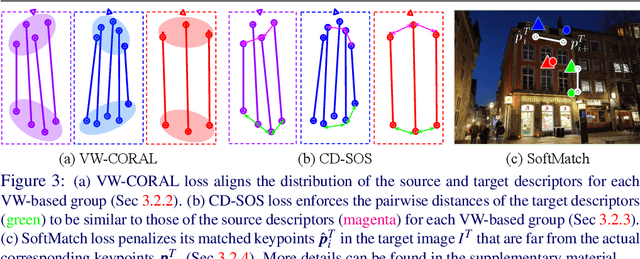
Abstract:We tackle the problem of visual localization under changing conditions, such as time of day, weather, and seasons. Recent learned local features based on deep neural networks have shown superior performance over classical hand-crafted local features. However, in a real-world scenario, there often exists a large domain gap between training and target images, which can significantly degrade the localization accuracy. While existing methods utilize a large amount of data to tackle the problem, we present a novel and practical approach, where only a few examples are needed to reduce the domain gap. In particular, we propose a few-shot domain adaptation framework for learned local features that deals with varying conditions in visual localization. The experimental results demonstrate the superior performance over baselines, while using a scarce number of training examples from the target domain.
InterHand2.6M: A Dataset and Baseline for 3D Interacting Hand Pose Estimation from a Single RGB Image
Aug 21, 2020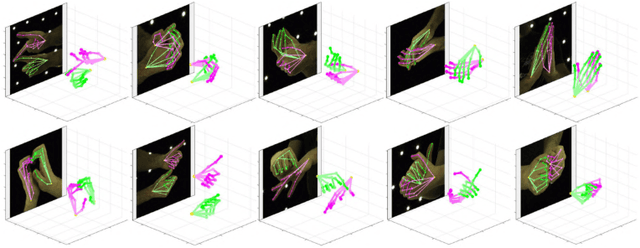
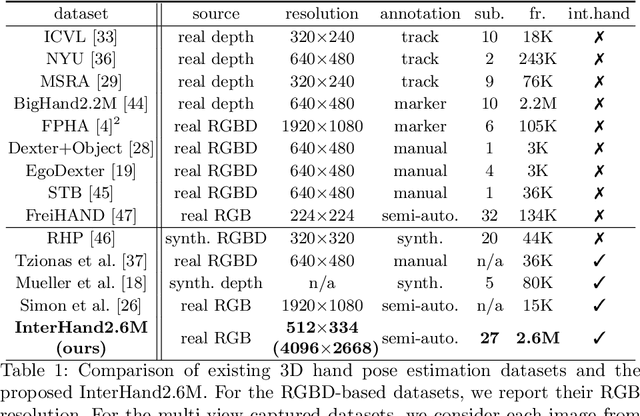

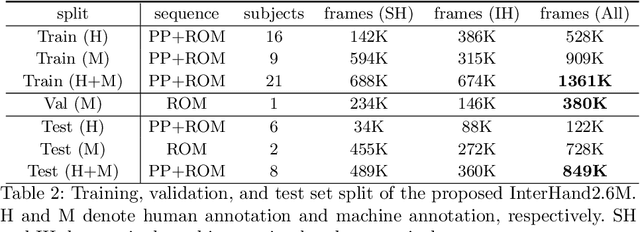
Abstract:Analysis of hand-hand interactions is a crucial step towards better understanding human behavior. However, most researches in 3D hand pose estimation have focused on the isolated single hand case. Therefore, we firstly propose (1) a large-scale dataset, InterHand2.6M, and (2) a baseline network, InterNet, for 3D interacting hand pose estimation from a single RGB image. The proposed InterHand2.6M consists of \textbf{2.6M labeled single and interacting hand frames} under various poses from multiple subjects. Our InterNet simultaneously performs 3D single and interacting hand pose estimation. In our experiments, we demonstrate big gains in 3D interacting hand pose estimation accuracy when leveraging the interacting hand data in InterHand2.6M. We also report the accuracy of InterNet on InterHand2.6M, which serves as a strong baseline for this new dataset. Finally, we show 3D interacting hand pose estimation results from general images. Our code and dataset are available at https://mks0601.github.io/InterHand2.6M/.
Pose2Mesh: Graph Convolutional Network for 3D Human Pose and Mesh Recovery from a 2D Human Pose
Aug 20, 2020



Abstract:Most of the recent deep learning-based 3D human pose and mesh estimation methods regress the pose and shape parameters of human mesh models, such as SMPL and MANO, from an input image. The first weakness of these methods is an appearance domain gap problem, due to different image appearance between train data from controlled environments, such as a laboratory, and test data from in-the-wild environments. The second weakness is that the estimation of the pose parameters is quite challenging owing to the representation issues of 3D rotations. To overcome the above weaknesses, we propose Pose2Mesh, a novel graph convolutional neural network (GraphCNN)-based system that estimates the 3D coordinates of human mesh vertices directly from the 2D human pose. The 2D human pose as input provides essential human body articulation information, while having a relatively homogeneous geometric property between the two domains. Also, the proposed system avoids the representation issues, while fully exploiting the mesh topology using a GraphCNN in a coarse-to-fine manner. We show that our Pose2Mesh outperforms the previous 3D human pose and mesh estimation methods on various benchmark datasets. The codes are publicly available https://github.com/hongsukchoi/Pose2Mesh_RELEASE.
DeepHandMesh: A Weakly-supervised Deep Encoder-Decoder Framework for High-fidelity Hand Mesh Modeling
Aug 19, 2020


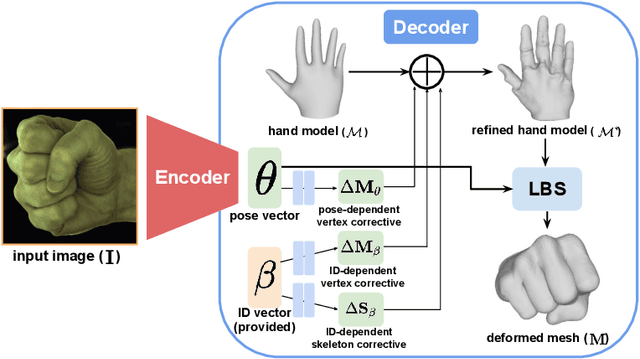
Abstract:Human hands play a central role in interacting with other people and objects. For realistic replication of such hand motions, high-fidelity hand meshes have to be reconstructed. In this study, we firstly propose DeepHandMesh, a weakly-supervised deep encoder-decoder framework for high-fidelity hand mesh modeling. We design our system to be trained in an end-to-end and weakly-supervised manner; therefore, it does not require groundtruth meshes. Instead, it relies on weaker supervisions such as 3D joint coordinates and multi-view depth maps, which are easier to get than groundtruth meshes and do not dependent on the mesh topology. Although the proposed DeepHandMesh is trained in a weakly-supervised way, it provides significantly more realistic hand mesh than previous fully-supervised hand models. Our newly introduced penetration avoidance loss further improves results by replicating physical interaction between hand parts. Finally, we demonstrate that our system can also be applied successfully to the 3D hand mesh estimation from general images. Our hand model, dataset, and codes are publicly available at https://mks0601.github.io/DeepHandMesh/.
I2L-MeshNet: Image-to-Lixel Prediction Network for Accurate 3D Human Pose and Mesh Estimation from a Single RGB Image
Aug 09, 2020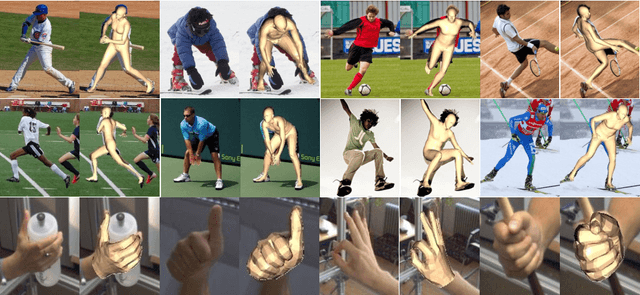

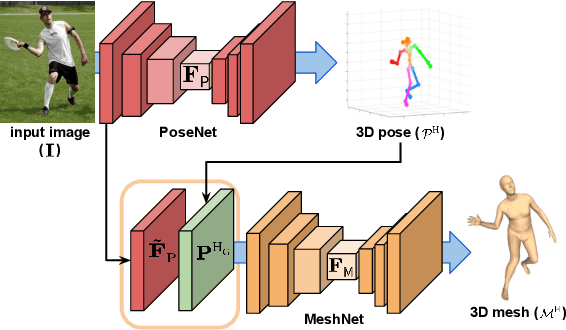
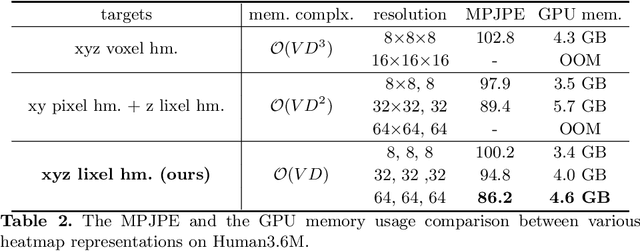
Abstract:Most of the previous image-based 3D human pose and mesh estimation methods estimate parameters of the human mesh model from an input image. However, directly regressing the parameters from the input image is a highly non-linear mapping because it breaks the spatial relationship between pixels in the input image. In addition, it cannot model the prediction uncertainty, which can make training harder. To resolve the above issues, we propose I2L-MeshNet, an image-to-lixel (line+pixel) prediction network. The proposed I2L-MeshNet predicts the per-lixel likelihood on 1D heatmaps for each mesh vertex coordinate instead of directly regressing the parameters. Our lixel-based 1D heatmap preserves the spatial relationship in the input image and models the prediction uncertainty. We demonstrate the benefit of the image-to-lixel prediction and show that the proposed I2L-MeshNet outperforms previous methods. The code is publicly available \footnote{\url{https://github.com/mks0601/I2L-MeshNet_RELEASE}}.
Visual Tracking by TridentAlign and Context Embedding
Jul 14, 2020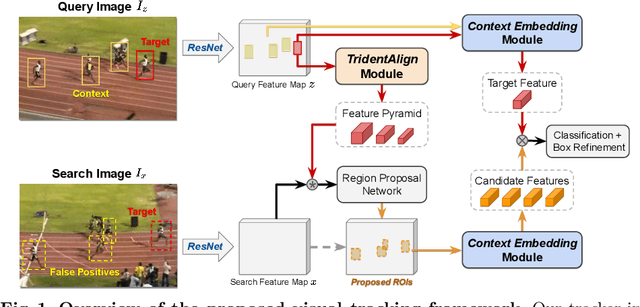

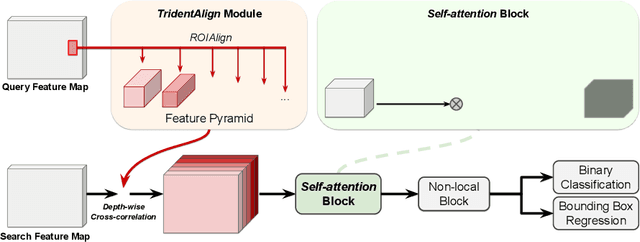

Abstract:Recent advances in Siamese network-based visual tracking methods have enabled high performance on numerous tracking benchmarks. However, extensive scale variations of the target object and distractor objects with similar categories have consistently posed challenges in visual tracking. To address these persisting issues, we propose novel TridentAlign and context embedding modules for Siamese network-based visual tracking methods. The TridentAlign module facilitates adaptability to extensive scale variations and large deformations of the target, where it pools the feature representation of the target object into multiple spatial dimensions to form a feature pyramid, which is then utilized in the region proposal stage. Meanwhile, context embedding module aims to discriminate the target from distractor objects by accounting for the global context information among objects. The context embedding module extracts and embeds the global context information of a given frame into a local feature representation such that the information can be utilized in the final classification stage. Experimental results obtained on multiple benchmark datasets show that the performance of the proposed tracker is comparable to that of state-of-the-art trackers, while the proposed tracker runs at real-time speed.
IntegralAction: Pose-driven Feature Integration for Robust Human Action Recognition in Videos
Jul 13, 2020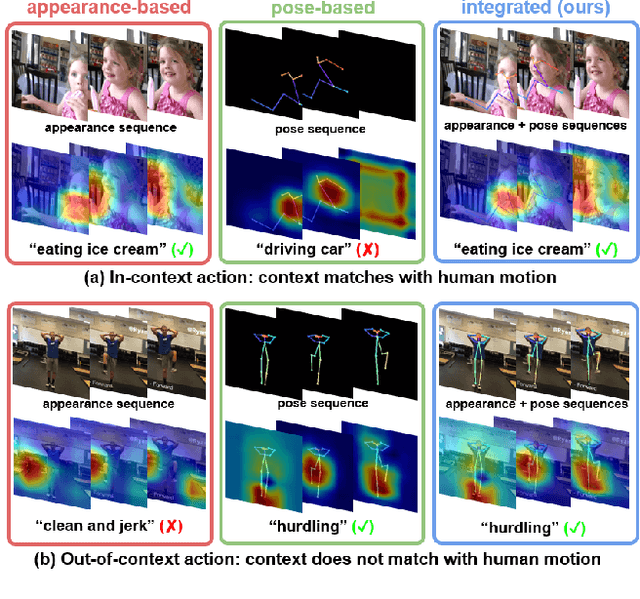

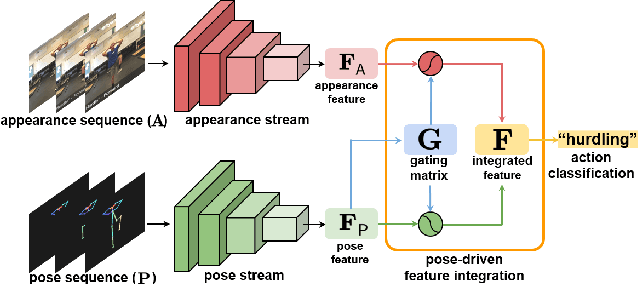
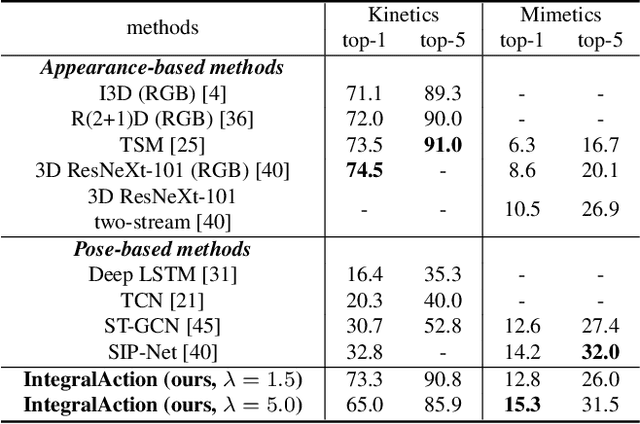
Abstract:Most current action recognition methods heavily rely on appearance information by taking an RGB sequence of entire image regions as input. While being effective in exploiting contextual information around humans, e.g., human appearance and scene category, they are easily fooled by out-of-context action videos where the contexts do not exactly match with target actions. In contrast, pose-based methods, which takes a sequence of human skeletons only as input, suffer from inaccurate pose estimation or ambiguity of human pose per se. Integrating these two approaches has turned out to be non-trivial; training a model with both appearance and pose ends up with a strong bias towards appearance and does not generalize well to unseen videos. To address this problem, we propose to learn pose-driven feature integration that dynamically combines appearance and pose streams by observing pose features on the fly. The main idea is to let the pose stream decide how much and which appearance information is used in integration based on whether the given pose information is reliable or not. We show that the proposed IntegralAction achieves highly robust performance across in-context and out-of-context action video datasets.
NTIRE 2020 Challenge on Image and Video Deblurring
May 10, 2020
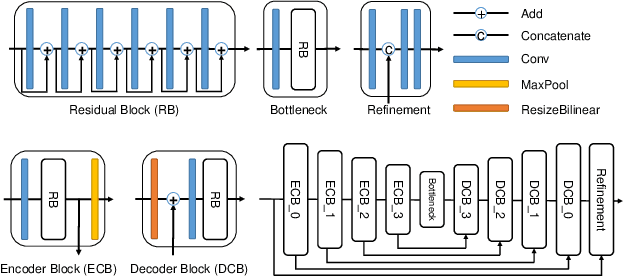

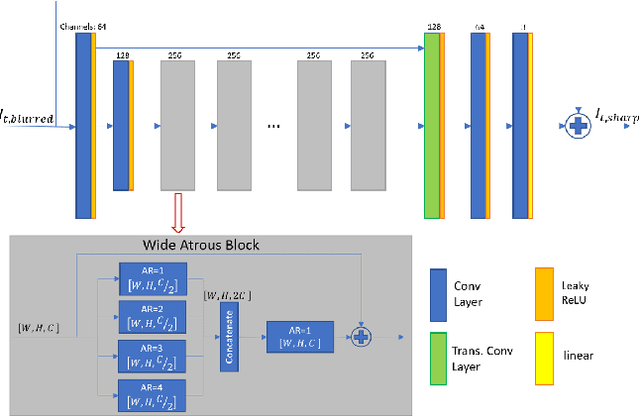
Abstract:Motion blur is one of the most common degradation artifacts in dynamic scene photography. This paper reviews the NTIRE 2020 Challenge on Image and Video Deblurring. In this challenge, we present the evaluation results from 3 competition tracks as well as the proposed solutions. Track 1 aims to develop single-image deblurring methods focusing on restoration quality. On Track 2, the image deblurring methods are executed on a mobile platform to find the balance of the running speed and the restoration accuracy. Track 3 targets developing video deblurring methods that exploit the temporal relation between input frames. In each competition, there were 163, 135, and 102 registered participants and in the final testing phase, 9, 4, and 7 teams competed. The winning methods demonstrate the state-ofthe-art performance on image and video deblurring tasks.
 Add to Chrome
Add to Chrome Add to Firefox
Add to Firefox Add to Edge
Add to Edge